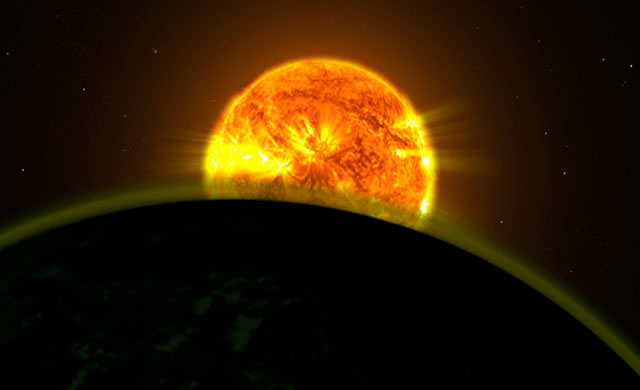
Utilizzando il potente occhio del telescopio spaziale Hubble della NASA, due squadre di scienziati hanno trovato indizi che fanno pensare alla presenza di acqua nelle atmosfere di cinque pianeti lontani. La presenza di acqua atmosferica è stata già segnalata in precedenza su alcuni pianeti extrasolari orbitanti attorno a stelle oltre il nostro sistema solare, ma questo è il primo studio atto a misurare definitivamente e confrontare i profili e le intensità di queste “firme” su più mondi.
I cinque pianeti, WASP – 17b , HD209458b , WASP – 12b , WASP- 19b e XO -1b – orbitano stelle vicine. I punti di forza delle loro firme caratteristiche per la rilevazione di acqua, varia da un pianeta all’altro, ma tutti e cinque ne riportano gli estremi. “Siamo molto fiduciosi nel vedere una “firma” riconducibile all’acqua su diversi pianeti”, ha dichiarato Avi Mandell, uno scienziato planetario del NASA Goddard Space Flight Center di Greenbelt, nel Maryland e autore principale di un documento pubblicato oggi sull’Astrophysical Journal, che descrive i risultati di WASP – 12b , WASP- 17b e WASP- 19b . “Questo lavoro davvero apre la porta per il confronto di quanta acqua sia presente nell’atmosfera di diversi tipi di pianeti extrasolari, per esempio quale più caldo rispetto a quelli più freddi. ” Gli studi fanno parte di un censimento delle atmosfere dei pianeti extrasolari guidati da L. Drake Deming dell’Università del Maryland a College Park. Entrambe le squadre hanno usato gli strumenti di Hubble Wide Field Camera 3 per esplorare i dettagli di assorbimento della luce attraverso le atmosfere dei pianeti. Le osservazioni sono state effettuate in un intervallo di lunghezze d’onda infrarosse, dove la “firma acqua”, sembrerebbe essere presente. Le squadre hanno confrontato le forme e l’intensità dei profili di assorbimento e la coerenza delle firme ha dato loro fiducia nel rilevare la presenza di acqua. Le osservazioni dimostrano continuando prestazioni esemplari di Hubble nella ricerca di pianeti extrasolari.
Using the powerful eye of NASA’s Hubble Space Telescope, two teams of scientists have found faint signatures of water in the atmospheres of five distant planets. The presence of atmospheric water was reported previously on a few exoplanets orbiting stars beyond our solar system, but this is the first study to conclusively measure and compare the profiles and intensities of these signatures on multiple worlds.
The five planets — WASP-17b (exoplanet in the constellation Scorpius that is orbiting the star WASP-17), HD209458b (extrasolar planet that orbits the Solar analog star HD 209458 in the constellation Pegasus), WASP-12b (extrasolar planet orbiting the star WASP-12 in the constellation Auriga), WASP-19b (extrasolar planet, notable for possessing one of the shortest orbital periods of any known planetary body. It orbits the star WASP-19a in the Vela constellation) and XO-1b (extrasolar planet approximately 560 light-years away in the constellation of Corona Borealis) — orbit nearby stars. The strengths of their water signatures varied. WASP-17b, a planet with an especially puffed-up atmosphere, and HD209458b had the strongest signals. The signatures for the other three planets, WASP-12b, WASP-19b and XO-1b, also are consistent with water. “We’re very confident that we see a water signature for multiple planets,” said Avi Mandell, a planetary scientist at NASA’s Goddard Space Flight Center in Greenbelt, Md., and lead author of an Astrophysical Journal paper, published today, describing the findings for WASP-12b, WASP-17b and WASP-19b. “This work really opens the door for comparing how much water is present in atmospheres on different kinds of exoplanets, for example hotter versus cooler ones.” The studies were part of a census of exoplanet atmospheres led by L. Drake Deming of the University of Maryland in College Park. Both teams used Hubble’s Wide Field Camera 3 to explore the details of absorption of light through the planets’ atmospheres. The observations were made in a range of infrared wavelengths where the water signature, if present, would appear. The teams compared the shapes and intensities of the absorption profiles, and the consistency of the signatures gave them confidence they saw water. The observations demonstrate Hubble’s continuing exemplary performance in exoplanet research.
Source/Continue reading → HubbleSite.org





















